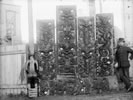Māori material culture, including carvings and weaving, was sought after by collectors and ethnologists from the time of British navigator James Cook’s explorations in the late 18th century. Despite a 1901 law to restrict their export from New Zealand, many treasures were taken overseas and were still held in museums and collections throughout the world in the 2000s.
House on the move
Often the centrepiece at an international exhibition was a major structure such as a Māori meeting house. The Mataatua meeting house from Whakatāne travelled to several exhibitions in the late 19th and early 20th centuries. In the 20th century exhibitions sometimes included Māori villages, depicting the daily life of the ‘old time Māori’.
Exhibitions
Traditional objects were regarded by Māori as taonga (treasures), imbued with the spirits of ancestors. However, Pākehā viewed them as colourful relics of a bygone age, and as such they were displayed at international exhibitions from the 1850s. Gradually, they came to be seen as symbols of New Zealand.
European-style artworks including painting and sculpture, and crafts made from local materials such as native woods, also revealed New Zealand’s uniqueness. Art depicting New Zealand’s natural wonders was shown at exhibitions from the early 1900s with the aim of boosting tourism.
Cultural sophistication
From the mid-20th century displays of contemporary art overseas revealed New Zealand as not just a tourist destination or source of produce, but a nation with a vibrant cultural life.
In the late 1940s the Department of External Affairs (which later became the Ministry of Foreign Affairs and Trade) developed an art collection to create a New Zealand ambience at overseas posts, to promote New Zealand artists and to enhance the country’s image as a sophisticated and high-achieving nation. In 2014 a selection of over 2,500 works were displayed at New Zealand embassies.
By design
New Zealand design has achieved world attention, and the primary reward has been economic. Particularly since the 1950s, industrial design, including appliances, furniture, household tools and agricultural equipment, has found export markets. In the late 1990s New Zealand fashion designers began showing at Australian Fashion Week and London Fashion Week to acclaim, with subsequent benefit for individual designers.
Diplomatic agendas also influenced the way art and craft was presented at international exhibitions. At Expo 70 in Japan, there were contemporary prints and paintings, murals by John Drawbridge and Roy Cowan, and New Zealand-made Japanese-influenced pottery. At the 1992 Seville Expo, the work of ceramicists and a glass artist were exhibited as Treasures of the Underworld.
Te Māori
A turning point in how traditional Māori art was displayed occurred with the Te Māori exhibition, which toured the United States in 1984 and New Zealand in 1986–87. Te Māori’s success in America affected the perception of Māori material culture back in New Zealand, in particular its spiritual significance.
Art festivals
New Zealand art has been represented at international festivals, including Australian events such as the Sydney Biennale, and from 2001 the famous Venice Biennale. New Zealand’s pavilion at the 2013 Venice Biennale attracted a record number of visits.









